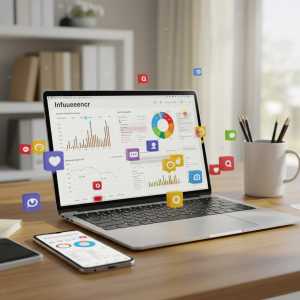Mastering Influencer Marketing Analytics: 10 Essential KPIs to Track ROI

Influencer marketing has become a cornerstone of modern digital strategies, enabling brands to tap into authentic voices and reach highly engaged audiences. However, as investment levels and campaign complexity rise, simply partnering with favorite creators is no longer sufficient. Savvy marketers must leverage data and analytics to unlock the full potential of their influencer initiatives. By tracking and optimizing the right metrics, brands can make informed decisions, refine targeting, allocate budgets effectively, and clearly demonstrate the return on investment (ROI) from every collaboration.
From impressions and engagement rates to sentiment analysis and cost per acquisition, these metrics cover both quantitative and qualitative dimensions of campaign effectiveness. We’ll also share tips on setting realistic goals, selecting the right analytics platforms, and translating data insights into actionable strategies. Whether you’re managing mega-celebrity partnerships or micro-influencer collaborations, tracking these metrics will help you maximize impact, optimize spend, and build stronger relationships with your audiences and influencer partners.
Reach and Impressions

Reach measures the total number of unique users who see your influencer’s content, while impressions represent the total views, including multiple exposures to the same user. High reach and impression counts indicate strong content visibility and audience penetration. Use native platform analytics—such as Instagram Insights, TikTok Analytics, or YouTube Studio—to track these metrics in real time. Comparing reach to impressions also reveals how frequently followers revisit or encounter shared content. By benchmarking these figures against previous campaigns or industry averages, you can set realistic visibility goals and choose influencers who consistently deliver broad exposure. Learn more about B2B Influencer Marketing
Engagement Rate
Engagement rate represents the percentage of an influencer’s audience that interacts with their content, including likes, comments, shares, and saves. Calculate engagement rate by dividing total engagements by total reach, then multiplying by 100. A high engagement rate indicates that content resonates with the audience and encourages interaction. Use tools like Sprout Social or Hootsuite Analytics to automate these calculations and compare engagement across different influencer collaborations. Keep in mind that micro-influencers often yield higher engagement rates due to more niche and loyal followings.
Click-Through Rate (CTR)
CTR tracks the percentage of viewers who click on a call-to-action link—such as a product page, landing page, or signup form—after viewing influencer content. Compute CTR by dividing clicks by impressions and multiplying by 100. This metric is critical for campaigns focused on driving traffic and lead generation. Implement unique UTM parameters in your influencer links to track clicks accurately in Google Analytics. By analyzing CTRs for different influencers and content formats, you can optimize calls to action, link placements, and creative styles to boost click performance.
Conversion Rate
Conversion rate measures the percentage of clicks that result in a desired action, such as completing a purchase, registering for a webinar, or downloading a guide. Calculate it by dividing conversions by total clicks and multiplying by 100. Integrate your influencer links with Google Analytics goals or e-commerce tracking to capture these conversion events. Monitoring conversion rates helps you evaluate the true business impact of each influencer partnership and informs budget allocation decisions. Conduct A/B tests on landing pages and promotional messaging to further improve conversion efficiency.
Cost per Acquisition (CPA)
CPA calculates the average cost required to acquire a customer or lead through your influencer campaigns. To determine CPA, divide the total campaign spend by the number of conversions. This metric enables a direct comparison of influencer performance based on cost efficiency. By benchmarking CPAs across different influencers or platforms, marketers can identify high-value partners, negotiate rates, and optimize budget distribution. Factor in both direct costs—such as influencer fees and ad spend—and indirect costs, including production expenses, to get a holistic view of acquisition economics.
Brand Sentiment
Sentiment analysis evaluates the tone of audience conversations surrounding your influencer campaigns, classifying mentions as positive, neutral, or negative. Tools like Brandwatch, Mention, or Sprout Social offer automated sentiment tracking across social media channels. By monitoring sentiment over the course of a campaign, brands can gauge public perception, address negative feedback quickly, and capitalize on positive buzz. Qualitative insights from sentiment analysis can guide creative adjustments, messaging tweaks, and influencer selection to maintain brand integrity and audience trust.
Audience Growth Rate
Audience growth rate measures how quickly your brand’s social media following increases as a result of influencer collaborations. Calculate this metric by dividing the number of new followers during the campaign by your starting follower count, then multiplying by 100. Comparing growth rates against your organic baseline reveals the incremental impact of influencer activity. Identifying which influencers drive the most follower growth helps you refine your collaboration strategy and focus on partnerships that build long-term community engagement.
Average Engagement per Post
While engagement rate provides a ratio, average engagement per post shows the raw number of interactions—likes, comments, and shares—each influencer generates. Compute this by dividing total engagements by the number of posts in the campaign. Average engagement helps set realistic performance benchmarks and enables more accurate forecasting of influencer output. When evaluating future collaborations, use this metric to estimate workload, expected interaction volumes, and potential campaign reach.
Share of Voice
Share of voice quantifies your brand’s visibility relative to competitors within the influencer marketing landscape. Determine share of voice by dividing your brand’s total mentions by the sum of mentions for all relevant competitors, then multiplying by 100. This KPI highlights how dominant your influencer campaigns are in category conversations. By monitoring share of voice across platforms, you can adjust influencer mixes, content types, and promotional tactics to capture more attention and outshine competitors.
Return on Investment (ROI)

ROI is the ultimate metric for quantifying the financial return generated by your influencer marketing efforts. Calculate ROI by subtracting total campaign investment from revenue generated, dividing the result by investment, and multiplying by 100. Use tracking methods like promo codes, affiliate links, or e-commerce integration to attribute revenue accurately. For a more comprehensive view, consider customer lifetime value (LTV) to assess long-term benefits. Present ROI data to stakeholders to justify budgets, refine strategies, and secure future campaign investments.
Conclusion
Effective influencer marketing transcends vanity metrics and demands a strategic, data-driven approach. By tracking these ten essential KPIs—ranging from reach and engagement to cost per acquisition and ROI—you gain a comprehensive understanding of campaign performance and can optimize for maximum impact. Start by setting clear objectives, selecting robust analytics platforms, and benchmarking against industry standards. Regularly review and adjust your strategies based on the insights you gather, and cultivate relationships with influencers who resonate with your brand values and audience demographics. In doing so, you’ll not only elevate your influencer marketing campaigns, but also drive sustainable growth, build authentic connections, and deliver tangible business results that matter.





